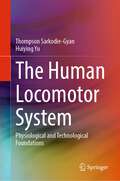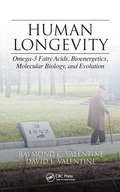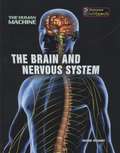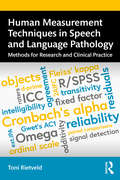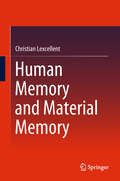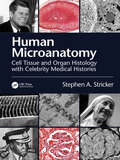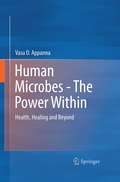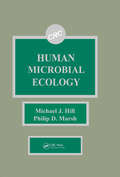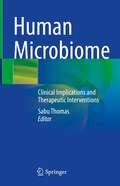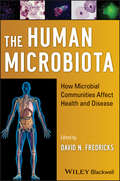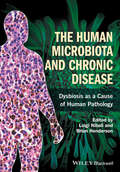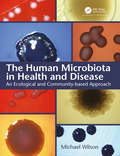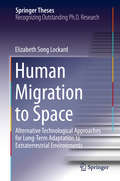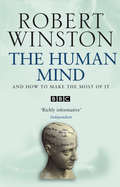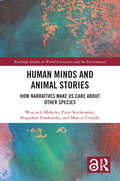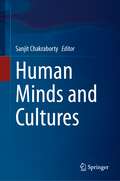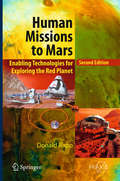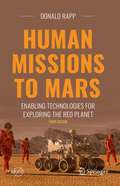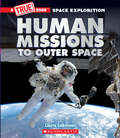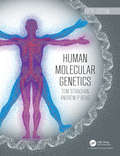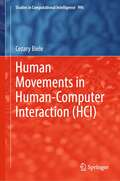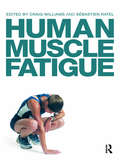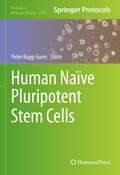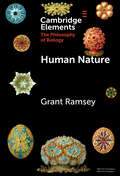- Table View
- List View
The Human Locomotor System: Physiological and Technological Foundations
by Thompson Sarkodie-Gyan Huiying YuThe textbook describes the complexity of the human dynamic behavior in space and its ability to produce coordinated, adaptive, dynamically stable movements under steady conditions while negotiating complex terrains and experiencing unexpected perturbations. Applying fundamental theories of biomechanics and physiology, the authors further consider the physical, perceptual, and motor aspects of the locomotor system towards the analysis of how humans can behave adaptively in space by virtue of their intelligent sensory-motor functions and to illuminate our understanding of how this complexity in behavior can provide insight into the neural control of locomotion of the musculoskeletal system. The text provides a foundation for describing the normal and abnormal human locomotor systems. The Human Locomotor System: Physiological and Technological Foundations is intended as a primary text for upper-undergraduate and graduate-level courses in neuroscience, gait analysis, kinesiology, physical therapy, sports science, and biomedical and rehabilitation engineering. It is also a valuable professional reference for scientists and engineers at medical and pharmaceutical companies involved in bioengineering research and development.
Human Longevity: Omega-3 Fatty Acids, Bioenergetics, Molecular Biology, and Evolution
by Raymond C. Valentine David L. ValentineMore than 7 billion people inhabit the earth and all of them are subject to aging. This book is aimed at persons interested in a molecular explanation of how our cells age. Human Longevity: Omega-3 Fatty Acids, Bioenergetics, Molecular Biology, and Evolution is built on the proposition that we age as our mitochondria age. It suggests a revised vers
The Human Machine: The Brain And Nervous System
by Richard SpilsburyWhat is a hypothalamus? How do reflexes work? Why is water important for a healthy brain? The Human Machine asks the questions that young people want answered. Each chapter contains a different question, so readers can develop their knowledge
Human Measurement Techniques in Speech and Language Pathology: Methods for Research and Clinical Practice
by Rietveld ToniHuman Measurement Techniques in Speech and Language Pathology gives an overview of elicitation methods in the assessment and diagnosis of speech and language disorders and explains approaches to the qualification of the obtained data in terms of agreement and reliability. Despite technological advances in the assessment and diagnosis of speech and language disorders, the role of human judgements is as important as ever. Written to be accessible to students, researchers and practitioners alike, the book not only provides an overview of elicitation procedures of human judgement such as visual analog scaling, Likert scaling etc. but also presents methodological and statistical approaches to quality assessment of judgements. The book introduces statistical procedures for processing scores obtained in paired comparisons and in the context of signal detection theory, and introduces software relevant for the calculation of a large number of coefficients of reliability and agreement. Featuring a wealth of reader-friendly pedagogy throughout, including instructions for using SPSS and R software, clarified by many illustrations and tables, example reports, and exercise questions to test the readers understanding, it is an ideal companion for advanced students and researchers in the field of speech pathology.
Human Memory and Material Memory
by Christian LexcellentThis book investigates the fascinating concept of a continuum between human memory and memory of materials. The first part provides state-of-the-art information on shape memory alloys and outlines a brief history of memory from the ancient Greeks to the present day, describing phenomenological, philosophical, and technical approaches such as neuroscience. Then, using a wealth of anecdotes, data from academic literature, and original research, this short book discusses the concepts of post-memory, memristors and forgiveness, highlights the analogies between materials defects and memory traces in the human brain. Lastly, it tackles questions of how human memory and memory of materials work together and interact. With insights from materials mechanics, neuroscience and philosophy, it enables readers to understand and continue this open debate on human memory.
Human Microanatomy: Cell Tissue and Organ Histology with Celebrity Medical Histories
by Stephen A. StrickerHuman Microanatomy is a comprehensive histology text that analyzes human structure and function from the subcellular to organ level of organization. In addition to emphasizing medically relevant information, each chapter considers developmental and evolutionary aspects of microanatomy while also using celebrity medical histories to help provide real-world context for accompanying descriptions of normal histology. The book is richly illustrated with over 1400 full-color micrographs and drawings assembled into cohesive groupings with detailed captions to help elucidate key histological concepts. Text illustrations are further supplemented by hundreds of other light and electron micrographs available in a free digital atlas covering a broad spectrum of microanatomy. Each text chapter also includes a preview, pictorial summary, and self-study quiz to highlight and review essential elements of histology. By incorporating features like medical histories, biological correlates, and various study aids, Human Microanatomy provides an appealing and informative treatment of histology for readers who are interested in the structural bases of cell, tissue, and organ functioning. KEY FEATURES: Uses celebrity medical histories to help provide context for descriptions of normal histology Supplements medically relevant information with developmental and evolutionary correlates of microanatomy Contains 1400+ full-color micrographs and drawings that illustrate a wide range of histological features Offers free access to an ancillary online atlas with hundreds of additional light and electron micrographs Includes helpful study aids such as chapter previews, pictorial summaries, and self-study quizzes Presents a novel and comprehensive account of the structure and function of human cells, tissues, and organs
Human Microbes - The Power Within: Health, Healing and Beyond
by Vasu D. AppannaThis book offers a unique perspective on the invisible organ, a body part that has been visualized only recently. It guides the readers into the world of the microbial constituents that make humans the way they are. The vitamins they produce, the smell they generate, the signals they create, and the molecular guards they elaborate are some of the benefits they bestow on humans. After introducing the notion as to why microbes are an integral component in the development of humans, the book examines the genesis of the microbiome and describes how the resident bacteria work in partnership with the skin, digestive tract, sexual organs, mouth and lungs to execute vital physiological functions. It then discusses the diseases that are triggered by the disruption of the harmonious relationships amongst these diverse systems and provides microbial cures to ailments such as obesity and digestive complications. Finally, the book focuses on the future when the workings of the human microbes will be fully unravelled. Societal changes in health education, the establishment of the microbiome bank, the fight against hunger, space travel, designer traits and enhanced security are explained. Each chapter is accompanied by captivating illustrations and ends with a visual summary. Dr. Appanna has been researching for over 30 years on various aspects of microbial and human cellular systems. He is a professor of biochemistry and has also served as Department Chair and Dean of the Faculty at Laurentian University, Sudbury, Canada. The book is aimed at readers enrolled in medical, chiropractic, nursing, pharmacy, and health science programs. Practicing health-care professionals and continuing education learners will also find the content beneficial.
Human Microbial Ecology
by Michael J. Hill Philip D. MarshThe aim of this comprehensively written volume is to provide a baseline of information on the normal microflora at various sites in the body. It focuses on the mouth, upper digestive tract, large intestine, skin, and urinogenital tract. Written in an easy-to-read format, this book highlights the level of detail available. For example, it explains that in the mouth and colon the data are extremely detailed and good quantitative information is available on large numbers of bacterial species. This work analyzes the similarities and differences between the microfloras of the various "internal" surfaces, and discusses the clear value of good taxonomy. It focuses on problems and extended research in the progress at other sites. Because this work researches the advances and discoveries made in specific areas of human microbial ecology, it is an ideal source for all who are involved in microbiology, bacteriology, and infectious diseases.
Human Microbiome: Clinical Implications and Therapeutic Interventions
by Sabu ThomasThe human microbiome refers to the complete microorganisms inhabiting the human body sites including skin, ear, nose, oral cavity, the genital, gastrointestinal and respiratory tracts, and body fluids such as breast milk, saliva, and urine. It is a significant and essential organ recognized for the body and has an established involvement in the host wellbeing, in terms of nutritional requirements and immunomodulation. This book talks about how alteration and imbalance in the same can have clinical implications associated with a multitude of gastrointestinal, lifestyle-associated, and neurodegenerative disorders. How the proliferation of specific groups of bacteria and their metabolic activities, as a result of intestinal dysbiosis leads to the 'leaky gut' condition thereby influences brain activity via the bidirectional gut-brain axis. It also coves the importance of microbial seeding and how it can be influenced by the mode of delivery, nutrition, and medication. This book also provides various therapeutic interventions such as the establishment of stool banks and Faecal microbiota transplantation (FMT) that have recently proved promising in the treatment of ASD, Inflammatory Bowel Disease, and Ulcerative Colitis. This book provides a deeper understanding of the development of the human gut microbiome and the factors driving its dysbiosis. This book is a valuable read for health professionals, medical students, nutritionists, and scientific research communities who are eager to update themselves with recent trends in microbiome research. It will also aid gastroenterologists and nutritionists to make well-informed choices regarding therapeutic regimes.
The Human Microbiota
by David N. FredricksThe Human Microbiota offers a comprehensive review of all human-associated microbial niches in a single volume, focusing on what modern tools in molecular microbiology are revealing about human microbiota, and how specific microbial communities can be associated with either beneficial effects or diseases. An excellent resource for microbiologists, physicians, infectious disease specialists, and others in the field, the book describes the latest research findings and evaluates the most innovative research approaches and technologies. Perspectives from pioneers in human microbial ecology are provided throughout.
The Human Microbiota and Chronic Disease: Dysbiosis as a Cause of Human Pathology
by Luigi Nibali Brian HendersonMicrobiota-associated pathology can be a direct result of changes in general bacterial composition, such as might be found in periodontitis and bacterial vaginosis, and/or as the result of colonization and/or overgrowth of so called keystone species. The disruption in the composition of the normal human microbiota, or dysbiosis, plays an integral role in human health and human disease.The Human Microbiota and Human Chronic Disease: Dysbioses as a Cause of Human Pathology discusses the role of the microbiota in maintaining human health. The text introduces the reader to the biology of microbial dysbiosis and its potential role in both bacterial disease and in idiopathic chronic disease states. Divided into five sections, the text delineates the concept of the human bacterial microbiota with particular attention being paid to the microbiotae of the gut, oral cavity and skin. A key methodology for exploring the microbiota, metagenomics, is also described. The book then shows the reader the cellular, molecular and genetic complexities of the bacterial microbiota, its myriad connections with the host and how these can maintain tissue homeostasis. Chapters then consider the role of dysbioses in human disease states, dealing with two of the commonest bacterial diseases of humanity - periodontitis and bacterial vaginosis. The composition of some, if not all microbiotas can be controlled by the diet and this is also dealt with in this section. The discussion moves on to the major 'idiopathic' diseases afflicting humans, and the potential role that dysbiosis could play in their induction and chronicity. The book then concludes with the therapeutic potential of manipulating the microbiota, introducing the concepts of probiotics, prebiotics and the administration of healthy human faeces (faecal microbiota transplantation), and then hypothesizes as to the future of medical treatment viewed from a microbiota-centric position. * Provides an introduction to dysbiosis, or a disruption in the composition of the normal human microbiota* Explains how microbiota-associated pathology and other chronic diseases can result from changes in general bacterial composition* Explores the relationship humans have with their microbiota, and its significance in human health and disease* Covers host genetic variants and their role in the composition of human microbial biofilms, integral to the relationship between human health and human disease Authored and edited by leaders in the field, The Human Microbiota and Human Chronic Disease will be an invaluable resource for clinicians, pathologists, immunologists, cell and molecular biologists, biochemists, and system biologists studying cellular and molecular bases of human diseases.About the Authors Luigi Nibali is a Senior Clinical Lecturer in the Clinical Oral Research Centre, Institute of Dentistry, Queen Mary University London in London, UK.Brian Henderson is a Professor of Microbial Diseases in the School of Life and Medical Sciences at University College London in London, UK.
The Human Microbiota in Health and Disease: An Ecological and Community-Based Approach
by Michael Wilson<p>A human being consists of a mammalian component and a multiplicity of microbes, collectively referred to as the "microbiota" or "microbiome," with which it has a symbiotic relationship. The microbiota is comprised of a variety of communities, the composition of each being dependent on the body site it inhabits. This community variation arises because the numerous locations on a human being provide very different environments, each of which favors the establishment of a distinct microbial community. Each community consists of bacteria, fungi and viruses with, in some cases, archaea and/or protozoa. <p>It is increasingly being recognized that the indigenous microbiota plays an important role in maintaining the health of its human host. However, changes in the overall composition of a microbial community at a body site, or an increase in the proportion of a particular species in that community, can result in disease or other adverse consequences for the host. <p><i>The Human Microbiota in Health and Disease: An Ecological and Community-Based Approach</i> describes the nature of the various communities inhabiting humans as well as the important roles they play in human health and disease. It discusses techniques used to determine microbial community composition and features a chapter devoted to the many factors that underlie this mammalian–microbe symbiosis. Uniquely, the book adopts an ecological approach to examining the microbial community’s composition at a particular body site and why certain factors can shift a community from a eubiotic to a dysbiotic state. <p>The book is for undergraduates and postgraduates on courses with a module on the indigenous microbiota of humans. It will also be useful to scientists, clinicians, and others seeking information on the human microbiota and its role in health and disease.</p>
Human Migration to Space
by Elizabeth Song LockardHuman migration to space will be the most profound catalyst for evolution in the history of humankind, yet this has had little impact on determining our strategies for this next phase of exploration. Habitation in space will require extensive technological interfaces between humans and their alien surroundings and how they are deployed will critically inform the processes of adaptation. As humans begin to spend longer durations in space--eventually establishing permanent outposts on other planets--the scope of technological design considerations must expand beyond the meager requirements for survival to include issues not only of comfort and well‐being, but also of engagement and negotiation with the new planetary environment that will be crucial to our longevity beyond Earth. Approaching this question from an interdisciplinary approach, this dissertation explores how the impact of interior space architecture can meet both the physical and psychological needs of future space colonists and set the stage for humankind to thrive and grow while setting down new roots beyond Earth.
The Human Mind
by Professor Lord Robert WinstonIt is the most complex and mysterious object in the universe. Covered by a dull grey membrane, it resembles a gigantic, convoluted fungus. Its inscrutability has captivated scientists, philosophers and artists for centuries. It is, of course, the human brain.With the help of science we can now begin to understand the extraordinary complexity of the brain's circuits: we can see which nerve cells generate electricity as we fall in love, tell a lie or dream of a lottery win. And inside the 100 billion cells of this rubbery network is something remarkable: you. In this entertaining and accessible book, Robert Winston takes us deep into the workings of the human mind and shows how our emotions and personality are the result of genes and environment. He explains how memories are formed and lost, how the ever-changing brain is responsible for toddler tantrums and teenage angst, plus he reveals the truth behind extra-sensory perception, déjà vu and out-of-body experiences. He also tells us how to boost our intelligence, how to tap into creative powers we never knew we had, how to break old habits and keep our brain fit and active as we enter old age.The human mind is all we have to help us to understand it. Paradoxically, it is possible that science may never quite explain everything about this extraordinary mechanism that makes each of us unique.
Human Minds and Animal Stories: How Narratives Make Us Care About Other Species (Routledge Studies in World Literatures and the Environment)
by Wojciech Małecki Piotr Sorokowski Bogusław Pawłowski Marcin CieńskiThe power of stories to raise our concern for animals has been postulated throughout history by countless scholars, activists, and writers, including such greats as Thomas Hardy and Leo Tolstoy. This is the first book to investigate that power and explain the psychological and cultural mechanisms behind it. It does so by presenting the results of an experimental project that involved thousands of participants, texts representing various genres and national literatures, and the cooperation of an internationally-acclaimed bestselling author. Combining psychological research with insights from animal studies, ecocriticism and other fields in the environmental humanities, the book not only provides evidence that animal stories can make us care for other species, but also shows that their effects are more complex and fascinating than we have ever thought. In this way, the book makes a groundbreaking contribution to the study of relations between literature and the nonhuman world as well as to the study of how literature changes our minds and society. "As witnessed by novels like Black Beauty and Uncle Tom’s Cabin, a good story can move public opinion on contentious social issues. In Human Minds and Animal Stories a team of specialists in psychology, biology, and literature tells how they discovered the power of narratives to shift our views about the treatment of other species. Beautifully written and based on dozens of experiments with thousands of subjects, this book will appeal to animal advocates, researchers, and general readers looking for a compelling real-life detective story." - Hal Herzog, author of Some We Love, Some We Hate, Some We Eat : Why It’s So Hard To Think Straight About Animals
Human Minds and Cultures
by Sanjit ChakrabortyThis book puts forward a harmonious analysis of similarities and differences between two concepts—human minds and cultures—and strives for a multicultural spectrum of philosophical explorations that could assist them in pondering the striking pursuit of envisaging human minds and cultures as an essential appraisal of philosophy and the social sciences. The book hinges on a theoretical understanding of the indispensable liaison between the dichotomy of minds and objectivity residing in semantic-ontological conjectures. The ethnographic sense of cultures confines the scope of cultural scientism, an evolutionary paradigm on the functionalist turn, where one could enthral the cultural phenomenon from the contentment of the conflict of scientific quandaries. Hence, cultural relativism concedes that cultures have some descriptive contents, like customs, beliefs, moral codes, other minds, etc., that are followed by an individual or a group of people. However, the notion of societalsemiotics embarks on the ‘semiotic conception of culture’ that deploys modernity and values centred on ethical conjectures. Human Minds and Cultures conspicuously attune the cultural edifice of moral minds and cope with the enduring prospects of ethics, genders, laws, and socio-political affairs. Essential reading for anyone with a sparkling interest in human minds and cultures.
Human Missions to Mars
by Donald RappA mission to send humans to explore the surface of Mars has been the ultimate goal of planetary exploration since the 1950s, when von Braun conjectured a flotilla of 10 interplanetary vessels carrying a crew of at least 70 humans. Since then, more than 1,000 studies were carried out on human missions to Mars, but after 60 years of study, we remain in the early planning stages. The second edition of this book now includes an annotated history of Mars mission studies, with quantitative data wherever possible. Retained from the first edition, Donald Rapp looks at human missions to Mars from an engineering perspective. He divides the mission into a number of stages: Earth's surface to low-Earth orbit (LEO); departing from LEO toward Mars; Mars orbit insertion and entry, descent and landing; ascent from Mars; trans-Earth injection from Mars orbit and Earth return. For each segment, he analyzes requirements for candidate technologies. In this connection, he discusses the status and potential of a wide range of elements critical to a human Mars mission, including life support consumables, radiation effects and shielding, microgravity effects, abort options and mission safety, possible habitats on the Martian surface and aero-assisted orbit entry decent and landing. For any human mission to the Red Planet the possible utilization of any resources indigenous to Mars would be of great value and such possibilities, the use of indigenous resources is discussed at length. He also discusses the relationship of lunar exploratio n to Mars exploration. Detailed appendices describe the availability of solar energy on the Moon and Mars, and the potential for utilizing indigenous water on Mars. The second edition provides extensive updating and additions to the first edition, including many new figures and tables, and more than 70 new references, as of 2015.
Human Missions to Mars: Enabling Technologies for Exploring the Red Planet (Springer Praxis Books)
by Donald RappIn this book, Donald Rapp looks at human missions to Mars from a technological perspective. He divides the mission into a number of stages: Earth’s surface to low-Earth orbit (LEO); departing from LEO toward Mars; Mars orbit insertion and entry, descent and landing; ascent from Mars; trans-Earth injection from Mars orbit and Earth return.A mission to send humans to explore the surface of Mars has been the ultimate goal of planetary exploration since the 1950s, when von Braun conjectured a flotilla of 10 interplanetary vessels carrying a crew of at least 70 humans. Since then, more than 1,000 studies were carried out. This third edition provides extensive updating and additions to the last edition, including new sections, and many new figures and tables, and references.
Human Missions to Outer Space: A True Book: Space Exploration (A True Book (Relaunch))
by Laurie CalkhovenFrom the first time a person looked up at the sky and wondered “What’s out there?” humans have dreamed about exploring the cosmos.This book is part of a series A True Book: Space Exploration, that includes the titles Human Missions to Outer Space, Mars Rovers, The International Space Station, and UFO's. The series features the latest NASA imagery and lively text to bring the wonder of space exploration directly to readers.About 60 years ago, the first manned spacecraft left Earth’s atmosphere for the first time. In the years since, astronauts have visited the moon several times—and have spent extended time living in outer space. We even have plans to send humans to Mars by the 2030s! Share in the joy of exploration and discovery with Human Missions to Outer Space.
Human Molecular Genetics (Human Molecular Genetics Ser.)
by Tom Strachan Andrew ReadHuman Molecular Genetics is an established and class-proven textbook for upper-level undergraduates and graduate students which provides an authoritative and integrated approach to the molecular aspects of human genetics. While maintaining the hallmark features of previous editions, the Fourth Edition has been completely updated. It includes new Key Concepts at the beginning of each chapter and annotated further reading at the conclusion of each chapter, to help readers navigate the wealth of information in this subject. The text has been restructured so genomic technologies are integrated throughout, and next generation sequencing is included. Genetic testing, screening, approaches to therapy, personalized medicine, and disease models have been brought together in one section. Coverage of cell biology including stem cells and cell therapy, studying gene function and structure, comparative genomics, model organisms, noncoding RNAs and their functions, and epigenetics have all been expanded.
Human Molecular Genetics
by Tom Strachan Andrew ReadHuman Molecular Genetics has been carefully crafted over successive editions to provide an authoritative introduction to the molecular aspects of human genetics, genomics and cell biology.Maintaining the features that have made previous editions so popular, this fifth edition has been completely updated in line with the latest developments in the field. Older technologies such as cloning and hybridization have been merged and summarized, coverage of newer DNA sequencing technologies has been expanded, and powerful new gene editing and single-cell genomics technologies have been added. The coverage of GWAS, functional genomics, stem cells, and disease modeling has been expanded. Greater focus is given to inheritance and variation in the context of populations and on the role of epigenetics in gene regulation. Key features: Fully integrated approach to the molecular aspects of human genetics, genomics, and cell biology Accessible text is supported and enhanced throughout by superb artwork illustrating the key concepts and mechanisms Summary boxes at the end of each chapter provide clear learning points Annotated further reading helps readers navigate the wealth of additional information in this complex subject and provides direction for further study Reorganized into five sections for improved access to related topics Also new to this edition – brand new chapter on evolution and anthropology from the authors of the highly acclaimed Human Evolutionary Genetics A proven and popular textbook for upper-level undergraduates and graduate students, the new edition of Human Molecular Genetics remains the ‘go-to’ book for those studying human molecular genetics or genomics courses around the world.
Human Movements in Human-Computer Interaction (Studies in Computational Intelligence #996)
by Cezary BieleThis book discusses human–computer interaction (HCI) which is a multidisciplinary field of study which aims at developing and implementing tools and techniques to attain an effective and efficient interaction between the humans (the users) and computers. In recent years, there is an increase of interest of HCI researchers and practitioners in the inclusion of gaze gestures which can greatly enhance the communication between the human user and the computer, as well as other more “physical” communication involving all what can be learned from movements of the human body, from face, hand, leg, foot, etc., to the whole body movement, even extending to the involvement of groups of agents, even society. These explicitly human-centric issues in the development, design, analysis, and implementation of the HCI systems are discussed in the book. A comprehensive state of the art is given complemented with original own proposals. As opposed to more traditional formal and IT based analyses, the discussion is here more focused on relevant research results from psychology and psychophysiology, and other soft, cognitive, etc., sciences. Remarks on the relevance of affective computing are also mentioned.
Human Muscle Fatigue
by Craig A. WilliamsWhen human muscle fatigues, athletic performance becomes impaired. For those individuals suffering muscle or metabolic diseases the effects of muscle fatigue can make everyday tasks difficult. Understanding the scientific processes responsible for skeletal muscle fatigue is therefore central to the study of the physiology of sport, exercise and health. Written by a team of leading international exercise scientists, this book explores the mechanisms of muscle fatigue and presents a comprehensive survey of current research on this important topic. Examining the wide variety of protocols, assessment methods and exercise models used to study muscle fatigue, the book explores the differential effects of fatigue as influenced by: age gender fitness and training the use of ergogenic aids medical conditions including cerebral palsy, muscular dystrophy and glycogenosis. Human Muscle Fatigue covers both clinical and applied approaches in sport and exercise physiology and devotes an entire section to the conceptual framework underpinning research in this area, helping readers from a wide range of backgrounds to engage with the topic. Accessible and detailed, this book is a key text for students and practitioners working in exercise and sports science, medicine, physical therapy and health.
Human Naïve Pluripotent Stem Cells (Methods in Molecular Biology #2416)
by Peter Rugg-GunnThis volume provides readers with a comprehensive collection of methods to guide them on how to generate, characterize, and use naïve human pluripotent stem cells (hPSCs). The chapters in this book cover topics such as three predominant routes to generate naïve hPSC lines; methods to differentiate naïve hPSCs into specialized cell types; and techniques to characterize naïve hPSCs using key molecular landmarks that benchmark and quality control the cell lines. Written in the highly successful Methods in Molecular Biology series format, chapters include introductions to their respective topics, lists of the necessary materials and reagents, step-by-step, readily reproducible laboratory protocols, and tips on troubleshooting and avoiding known pitfalls. Cutting-edge and thorough, Human Naïve Pluripotent Stem Cells: Methods and Protocols is a valuable resource for novice and expert researchers who are looking to learn more or expand their research in this developing field.
Human Nature (Elements in the Philosophy of Biology)
by Grant RamseyHuman nature is frequently evoked to characterize our species and describe how it differs from others. But how should we understand this concept? What is the nature of a species? Some take our nature to be an essence and argue that because humans lack an essence, they also lack a nature. Others argue for non-essentialist ways of understanding human nature, which usually aim to provide criteria for sorting human traits into one of two bins, the one belonging to our nature and the other outside our nature. This Element argues that both the essentialist and trait bin approaches are misguided. Instead, the author develops a trait cluster account of human nature, which holds that human nature is based on the distribution of our traits over our (actual and possible) life histories. One benefit of this account is that it aligns human nature with the human sciences, rendering the central concern of the human sciences to be the study of human nature. This title is also available as Open Access on Cambridge Core.
